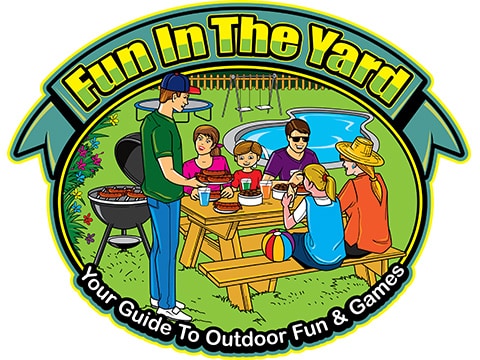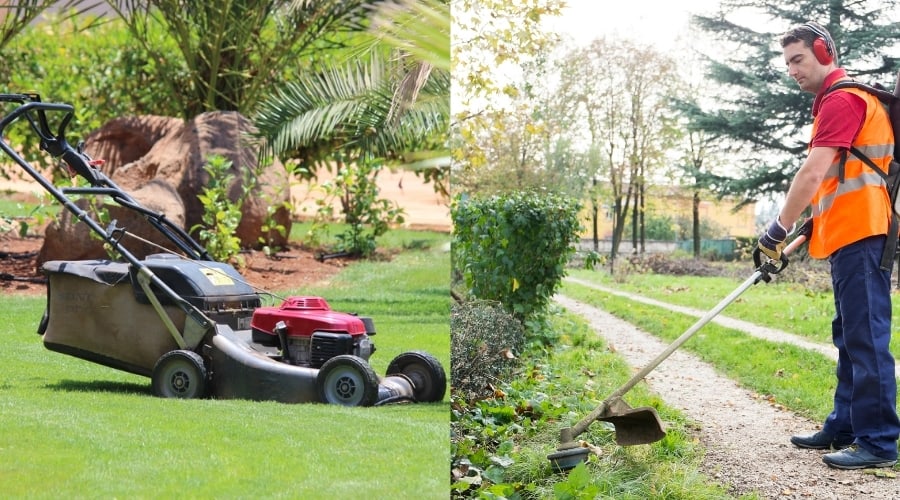To create the perfect lawn, should you mow the grass first and then cut the weeds or weedeat first and then cut the grass afterward?
Professional gardeners recommend mowing first in order to eliminate large amounts of unwanted grass and weeds with speed before moving on to refinements and details with a weedeater. Mowing first gives neater and more precise results because it establishes a guide height for the weedeater to cut the edges and borders with.
In this article, I explore the expert’s opinions to help you find the best mowing and strimming strategies for your garden.
Table of Contents
Is It Better to Weedeat Or Mow First
While most professional gardeners recommend mowing first, plenty of people weedeat first and still get a great result. It depends on your priorities for the garden.
Mowing first is the least labor-intensive strategy because you’re eliminating large amounts of unwanted material at speed before you move on to refinements and fine detailing.
But weedeating first reduces the amount of cleanup work because you can just run over the weeds as you mow the grass instead of collecting them later.
I prefer to mow first. It enables me to match my edges and borders to the length of the newly shorn grass with more accuracy. I’m with the professionals on this one but there are advantages to both approaches.
I’ve heard some professionals say mowing over weeds makes them worse and you should always treat and remove the weeds before you cut the lawn.
It requires pre-planning and prep work and most homeowners haven’t got time to wait around for the weeds to die before they can mow the grass.
There is a chance of weed spores disseminating and spreading across the lawn whether you mow or weedeat first. It could be argued that the likelihood of this happening is greater if you mow over the top of tall weeds because there’s less precision involved.
For me, it’s a moot point if you’ve got an untidy lawn that needs prompt action and not enough patience or time to apply weed killer first.
In my experience, the difference between mowing over weeds and trimming them, in terms of spore dispersal, is fairly negligible.
What really matters is what you do afterwards. Trimmed or mown, the weeds will still need to be treated at their roots. If you don’t treat them before you manicure the lawn, you should do it later.
Apply an effective pesticide to the grass and then leave the lawn as undisturbed as possible for 3 to 4 days. Avoid walking or playing on it.
Benefits To Mow First Then Weedeat
- Arguably results are neater and more precise. Mowing first establishes a guide height for the edges and borders.
- Quicker, especially if your lawn is overgrown. It’s faster to remove as much unwanted material as possible and then turn to precision cutting/trimming.
- Mowing first eliminates the risk of running over already trimmed edges and having to redo them.
- Weedeating after mowing is a quick and easy way to correct turn around marks and other spots missed with the mower.
Most professional gardeners and landscapers prefer to mow first and then weedeat after. For most homeowners as well, it just feels like the natural way to do things.
Weed eaters can be used to cut fairly large areas of grass, especially if they’re overgrown, but they perform best when used for ‘spot work’ and targeted trimming.
For most, it makes sense to remove as much grass as possible with a non-precise tool like a lawnmower first. That way, the majority of the physical labor gets done as quickly and as effortlessly as possible and energy isn’t wasted trimming spots that can be mown over in seconds.
There are some minor downsides such as having to momentarily slow the pace to judge how close to obstacles and edges you should get.
It’s also worth mentioning some professionals believe mowing over tall weeds causes their spores to spread and create more weeds in the weeks afterward.
It’s not altogether untrue but any kind of cutting, weed eating included, has the potential to do this. It’s better to spot-treat the weeds before you cut your lawn but, of course, there isn’t always time for that.
Benefits To Weedeat First Then Mow
- Faster cleanup. Collect the weed cuttings with the mower instead of having to rake/leaf blow them later.
- From mower basket to compost heap. Collect, keep and use your weed cuttings for composting.
- Can target and trim patches of weeds before mowing to potentially limit the spread of spores.
- If the weed-eater is used as an edger before the grass gets mown, you won’t need to push your mower as close to obstacles like walkways and ornamental borders.
Even though most professionals mow first and weedeat second, they still acknowledge that great results can come from the opposite strategy and encourage homeowners to go with whatever approach they’re most comfortable with.
Plus, there’s an undeniable benefit to weedeating before you mow and it’s a much quicker, easier cleanup.
If you weedeat after mowing, you’re just going to leave trimmed weeds and grass clippings strewn across your freshly cut lawn.
The advantage of weedeating first is that you can mow over the clippings and collect them at the same time. It saves you having to use a rake or leaf blower to manually collect the clippings later.
Provided you take care when mowing around the borders and edges you’ve already trimmed with the weed eater, it can be helpful to have those pre-trimmed lines to indicate how close to get to these obstacles.
You’re less likely to mow too close to a walkway or flower border because it’s obvious where the grass has been cut already.
Helpful Tips To Know About Which To Do First, Weedeat or Mow
Hopefully, you can see by now that the decision is yours. Professional gardeners may recommend the quicker, easier method of mowing first but plenty of other people swear by the opposite strategy.
It depends on your priorities. Are you most concerned with getting the job done fast and leaving the minimal mess to clear away? Is precision your goal and you don’t mind dedicating more time and effort to achieving it?
Here are some tips to help you decide on the right strategy for you:
- Weedeat first and mow second if you want to clean up as you work and eliminate the need for raking later.
- Mow first and weedeat second to clear overgrown grass quickly and avoid having to precision trim areas that don’t need it.
- Don’t expect weeds to be vanquished just because you’ve mown or trimmed them. Eradication requires treatment with an appropriate pesticide or other weed-killing substance. If you’re very concerned about spores, carefully spot trim tall or thick weed patches before you mow the rest of the lawn.
- Do not mow too frequently or you’ll weaken the grass. Maintain a height of three inches or longer to promote healthy regrowth and ensure your lawn has a crisp, tidy appearance.
Final Thoughts
There’s much debate over the correct way to maintain a healthy lawn and whether or not it’s better to mow or weedeat first.
Generally, the consensus among professionals is to mow first and weedeat afterward but it’s more of a recommendation than a rule. If you’re happy with the method you’re currently using, keep it up.

